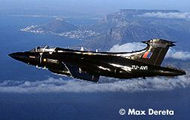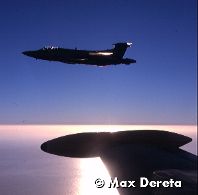|





toll free: 1-800-644-7382 Incredible
Adventures
Sarasota, Florida
email
voice: 941-346-2603
FAX: 941-346-2488
|
 |
======================================
CAPE
TOWN JETS: Buccaneer
======================================
Jet
flights are no longer available in Cape Town...to learn about
other great flying adventures, visit www.incredible-adventures.com
 |
Twin engine tandem seat low
level strike attack aircraft powered by two Rolls Royce Spey non-afterburning
bypass turbofans developing 12600 lb. static thrust each.
Equipped with terrain hugging
radar, this attack aircraft is at its peak prowess low and fast. "Most
air forces do have fast jets which were specially designed for the ground-attack
mission. Almost certainly the best have been subsonic, examples being the
Grumman A-6 Intruder and the BAE Buccaneer. They are superior because,
compared with supersonic aircraft, they carry more, fly further, and can
make their attack with at least equal precision and probably at lower altitude.
As for speed, none of the supersonic types can actually attack at supersonic
speed, and with its internal bombload of 4000 lb. the Buccaneer was faster
than (for example) a Jaguar, Phantom, F-111, Mirage, F-15E, Tornado or
Su-24 with the same load !" (The Encyclopedia of Modern Warplanes;
The Development and Specifications of all Active Military Aircraft; Bill
Gunston; ©1995 Aerospace Publishing Limited)
 |
"The Buccaneer is a particularly
good machine, with excellent performance 'on the deck' because of careful
aerodynamic design, and first-class low-speed handling characteristics
as a result of a 'super-circulation' boundary-layer control system. Transonic
speeds are dangerous at very low altitudes, where buffeting might cause
the aircraft to hit the ground before the pilot can correct. Design adjustments
to prevent this buffeting are based on the American-developed theory of
'area-ruling' the fuselage to minimize drag and turbulent areas. First
introduced on the F-102 Delta Dart, area ruling has since been used on
a number of aircraft and can usually be seen in the fuselage, which has
a number of waisting and bulging effects on it. In the Buccaneer there
is a distinct bulge just aft of the rear end of the jet pipes."
"On account of rapidly improving air defense systems, the requirement
for attack aircraft to be able to penetrate deep into enemy territory involved
the aircraft coming very low, underneath the radar, thus leaving no chance
for interception until it is too late. This option demands aircraft of
great strength, for turbulence is acute at very low levels, and advanced
avionics, with forward, downward and sideways looking radar hooked into
a computer which can fly the aircraft round or over obstacles in its path
much more surely than a pilot can. The very rigid structure of the Buccaneer
proved ideal for the task" ("Aviation, an Illustrated History",
Christopher Chant, ©1983 Orbis Publishing, London)
E-mail
or call us today for a full color brochure, schedules, details
and rates: 800 644-7382
|